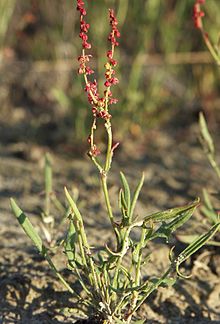- Rumex acetosella
-
Rumex acetosella 
Scientific classification Kingdom: Plantae (unranked): Angiosperms (unranked): Eudicots (unranked): Core eudicots Order: Caryophyllales Family: Polygonaceae Genus: Rumex Species: R. acetosella Binomial name Rumex acetosella
L.Rumex acetosella is a species of sorrel, also known as Acetosella vulgaris Fourr,[1] bearing the common names sheep's sorrel, red sorrel, sour weed, and field sorrel. The plant and its subspecies are common perennial weeds. It has green arrowhead-shaped leaves and red-tinted deeply ridged stems, and it sprouts from an aggressive rhizome. The flowers emerge from a tall, upright stem. Female flowers are maroon in color.
Contents
Growth
The plant is native to Eurasia but has been introduced to most of the rest of the northern hemisphere although Stace (1992) has informed that it is native to the British Isles. In North America it is a common weed in fields, grasslands, and woodlands. It favors moist soil, so it thrives in floodplains and near marshes. It is often one of the first species to take hold in disturbed areas, such as abandoned mining sites, especially if the soil is acidic. Livestock will graze on the plant, but it is not very nutritious and contains oxalates which make the plant toxic if grazed in large amounts.
R. acetosella is a host plant for Lycaena phlaeas, also known as the American Copper or Small Copper butterfly.
Characteristics
R. acetosella is a perennial herb that has an upright stem that is slender and reddish in color, and branched at top, reaching a height of 18 inches (0.5 meters). The arrow-shaped leaves are simple, slightly more than 1 inch (3 cm) in length, and smooth with a pair of horizontal lobes at base. Flowers from March to November, when yellowish-green flowers (male) or reddish (female) flowers develop on separate plants, at the apex of the stem. Fruits are red achenes.
Sheep's sorrel is widely considered to be a noxious weed, and one that is hard to control due to its spreading rhizome. Blueberry farmers are familiar with the weed, due to its ability to thrive in the same conditions under which blueberries are cultivated. It is commonly considered by farmers as an Indicator plant of the need for liming.
Culinary uses
There are several uses of sheep sorrel in the preparation of food including a garnish, a tart flavoring agent, a salad green, and a curdling agent for cheese. The leaves have a lemony, tangy or nicely tart flavor.
Medicinal uses
Sheep Sorrel contains constituents including beta carotene, tartaric acid, oxalates (oxalic acid), anthraquinones (chrysophanol, emodin, Rhein), glycosides like hyperoside, the quercitin-3d-galactoside.
It has a number of purported uses and folk remedies that include treatment for inflammation, cancer, diarrhea, scurvy and fever. A tea made from the stem and leaves can be made to act as a diuretic. It also has certain astringent properties and uses. Other historical uses include that of a vermifuge, as the plant allegedly contains compounds toxic to intestinal parasites (worms).
The entire plant, including the root, is used as a cancer treatment,[citation needed] and is a primary ingredient in a preparation commonly referred to by the name Essiac.
Revegetation in the Australian Alps
From the 1950s, the New South Wales Soil Conservation Service undertook an extensive program of rehabilitation of the vegetation of the Carruthers Peak–Mount Twynam area, which was in sore need of help after a century of grazing. They tried various methods using bitumen, wire netting and bales of straw, however none were very successful[vague]. However, Sheep Sorrel was present in the bales of straw, and in fact helped to hold the soil for recolonisation by the native vegetation.
Notes
References
- C.A. Stace, (1992). New Flora of the British Isles. Press Syndicate of the University of Cambridge, The Pitt Building, Trumpington Street, Cambridge CB2 1RP.
- http://www.mskcc.org/mskcc/html/11571.cfm?RecordID=464&tab=HC
- http://www.viable-herbal.com/herbdesc3/1sheepso.htm
- http://www.allaboutpetswa.com/natural__therapies_for__animals%20-cancer.htm
- http://www.naturesgarden.ca/sheep_sorrel_recipe.htm
- Rumex acetosella; Missouri Botanical Garden's efloras.org.
- Weed of the Week - USDA Forest Service
External links
Categories:- Invasive plant species
- Flora of Europe
- Medicinal plants
- Rumex
Wikimedia Foundation. 2010.
